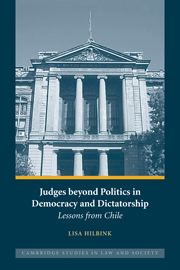Book contents
- Frontmatter
- Contents
- Acknowledgments
- Introduction
- 1 The Judiciary, the Rule of Law, and Democracy: Aspirations and Impediments
- 2 The Institutional Construction of the Judicial Role in Chile
- 3 Conservative Activism in the Heyday of Democracy, 1964–1973
- 4 Legitimizing Authoritarianism, 1973–1990
- 5 Continuity and Change after the Return to Democracy, 1990–2000
- 6 Conclusions and Implications
- Appendix A Orienting Information on Chilean Law and Courts
- Appendix B List of Interviewees (alphabetical by category)
- References
- Index
Appendix A - Orienting Information on Chilean Law and Courts
Published online by Cambridge University Press: 08 January 2010
- Frontmatter
- Contents
- Acknowledgments
- Introduction
- 1 The Judiciary, the Rule of Law, and Democracy: Aspirations and Impediments
- 2 The Institutional Construction of the Judicial Role in Chile
- 3 Conservative Activism in the Heyday of Democracy, 1964–1973
- 4 Legitimizing Authoritarianism, 1973–1990
- 5 Continuity and Change after the Return to Democracy, 1990–2000
- 6 Conclusions and Implications
- Appendix A Orienting Information on Chilean Law and Courts
- Appendix B List of Interviewees (alphabetical by category)
- References
- Index
Summary
Chile, like all Latin American countries, has a legal and judicial system constructed primarily in the civil law tradition. The judiciary is thus organized much like a state bureaucracy, which judges enter at the bottom rung and work their way up via the promotion process discussed in Chapter 1.
Chile is a unitary (i.e., not federal) state and thus has a single judicial hierarchy. At the bottom are the approximately 450 district-level courts, most of which specialize in civil, criminal, labor, or family cases (some have mixed jurisdiction). Each is presided over by a single judge and a judicial secretary. These courts have no constitutional jurisdiction. Above these are the seventeen courts of appeal, which are divided into chambers in which three judges preside. These courts handle recursos de apelación, general appeals that call for the review of both the facts and the law of a case decided in a lower court, or of any significant procedural decisions made by the lower court judge in her treatment of the case. Appellate courts also have first instance constitutional jurisdiction for recursos de amparo (writs of habeas corpus) and recursos de protección (equivalent writs which cover rights other than those covered by amparo and excluding socioeconomic or “third-generation” rights), as well as first-instance jurisdiction in cases involving violations of the Law of Internal State Security.
- Type
- Chapter
- Information
- Judges beyond Politics in Democracy and DictatorshipLessons from Chile, pp. 251 - 256Publisher: Cambridge University PressPrint publication year: 2007



